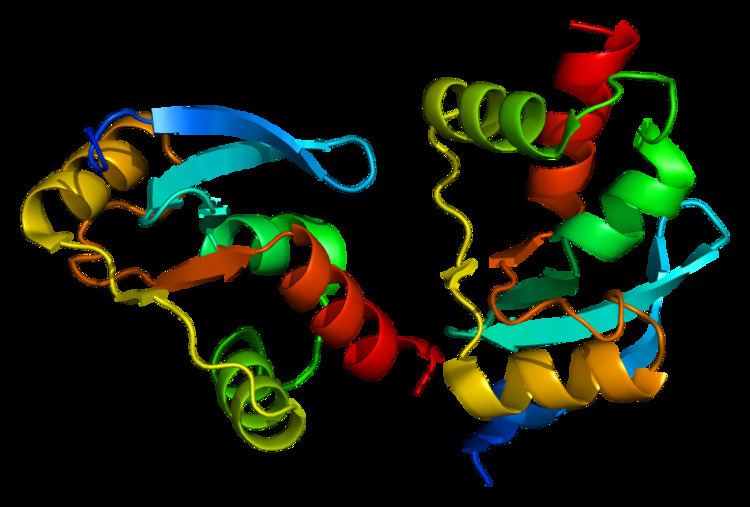Entrez 1602 | Ensembl ENSG00000276644 | |
 | ||
Aliases DACH1, DACH, dachshund family transcription factor 1 External IDs MGI: 1277991 HomoloGene: 7288 GeneCards: DACH1 | ||
Dachshund homolog 1, also known as DACH1, is a protein which in humans is encoded by the DACH1 gene. DACH1 has been shown to interact with UBE2I, Smad4 and NCoR.
Contents
Structure
This protein coding gene has 760 amino acid protein, and an observed molecular weight of 52 kDa. Dachshund Family transcription factor 1 is encoded by DACH gene, who spans 400kDa and is encoded by 12 exons. This gene is located, in humans, in chromosome 13 (13q22). It encodes a chromatin-associated protein that associates with other DNA-binding transcription factors to regulate gene expression and cell fate determination during development.
Multiple transcript variants encoding different isoforms have been found for this gene. DACH mRNA was detected in multiple human tissues, including kidney and heart.
It finds in nucleus of the cells, and it is considered a cell fate determination factor.
Dachshund domain 1 (DD1, also known as Box-N) has a predicted helix–turn–helix family structure.
The X-ray crystal structure of the human DACH1 Box-N illustrates that the DACH1 protein contains a domain that is conserved with the pro-oncogenes ski/sno oncogenes, which form an α/β structure similar to that found in the winged helix/forkhead subgroup of DNA binding proteins.
This protein is widely expressed. We can find it in bone marrow, brain, colon, eye, heart, kidney, leucocyte, liver, lung, pancreas, pineal gland, placenta, prostate, retina, skeletal muscle, small intestine and spleen.
Function
This gene is similar to the D. melanogaster dachshund gene, which encodes a nuclear factor essential for determining cell fates in the eye, leg, and nervous system of the fly. It is a member of the Ski gene family and is thought to be involved in eye development. Four alternatively spliced transcripts encoding different isoforms have been described for this gene.
DACH1 protein is able to prevent the proliferation of cancerous cells due to being a natural repressor of estrogen receptors in the normal function of mammary tissue.
DACH1 also has other functions related to cell activity. It down regulates transcriptions from RNA polymerase II promoter in order to bind the factor activity which is involved in negative regulation of transcription. This protein is able to do this by interacting selectively and non-covalently with a sequence of DNA which is near the core promoter for RNA polymerase II. It also interacts with this sequence of DNA to bind the activity of the factor involved in the transcription in preinitiation complex assembly. Another important function that is related with this protein is cell proliferation. This implies that the cells will start to reproduce increasing the cell population. DACH1 plays an important role on this precursor of cell proliferation in retinal and pituitary.
DACH1 is responsible for the inhibition of cell migration. Some other processes that DACH1 protein regulates by reducing the frequency, are the transcription of a specific gene, the synthesis process of DNA and the reproduction of fibroblast cells.
This protein is also responsible of the gas exchange of oxygen and carbon dioxide between the nature and the organism.
Disease relevance
DACH1 is envolved in two principal diseases:
Breast tumor growth
DACH1 is a cell fate determination factor that inhibits Cyclin D1 and thereby inhibit cell proliferation of Breast Tumor.
Normal cells and some breast cancer cells have receptors that bind estrogen and progesterone. These two hormones often promote the growth of breast cancer cells.
Approximately 70% of breast cancers are ER+, which means that these estrogen receptors are present. DACH1 expression decreases when the cancer is more invasive and the level of estrogen is high.
The role of DACH1 in the inhibition of oncogene-induced cellular migration and metastasis is well established in breast cancer cells.
Dach1 inhibited oncogene-mediated breast oncogenesis, blocking breast cancer epithelial cell DNA synthesis, colony formation, growth in Matrigel, and tumor growth in mice.
Nephropathy
DACH1 plays an important role in retinal and pituitary precursor cell proliferation. Dach1 regulates early progenitor cell proliferation during mammalian retinogenesis and pituitary development by directly repressing cyclin-dependent kinase inhibitors.
Dach1 is highly expressed in the adult podocyte, with transcripts showing an approximate ten fold enrichment compared to total kidney cortex. It is also more widely expressed in the earlier developing kidney, but again including definite podocyte expression.
The Dach1 mutant mice exhibit early postnatal death, although no developmental defects were detected in any organ system examined, including kidneys.
